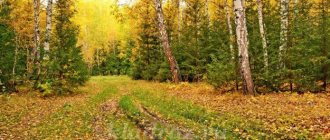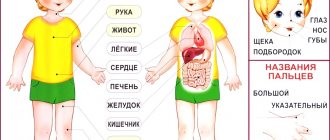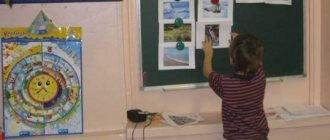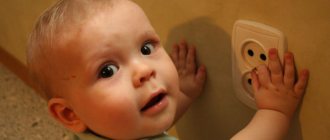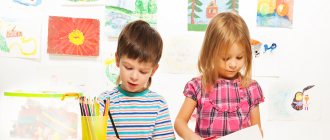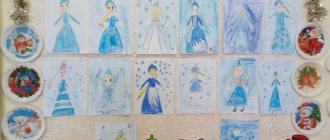Summary of a lesson on cognitive development in the middle group on the topic: “Spring Miracles.”
- March 29, 2017
International and All-Russian competitions
All-Russian competition of pedagogical excellence “Methodological piggy bank of a kindergarten teacher”
Program content: to form children's knowledge about the spring season; introduce the names of the seasons and their sequence; introduce changes in the life of some forest animals in the spring; clarify existing ideas about the changes occurring in nature in spring; activate children's vocabulary on the topic “Spring”; improve the grammatical structure of speech; to develop in children the ability to listen and understand speech addressed to them; answer questions, participate in a group conversation; promote the emergence and establishment of cause-and-effect relationships by children; to cultivate a kind, caring attitude towards nature, the ability to appreciate its beauty.
Equipment : Tape recorder (audio recording of a spring stream and the sounds of a spring forest).
Demo material:
Illustrations depicting the seasons (autumn, winter, spring), pictures depicting wind, rain, sun, birdhouse with starling. Poplar branches with blossoming leaves; painting “Spring Meadow”; illustrations of wild animals: (bear, wolf, fox, hare) flowers: (snowdrop, coltsfoot, tulips, daffodils.
Preliminary work : observations in nature; memorizing poems, riddles about spring, primroses; viewing the album “Spring”; compiling descriptive stories about spring, reading fiction on the topic, listening to audio recordings “Sounds of Nature”.
Progress of the lesson
Teacher:
Come to me, my friend, quickly join the circle. On the right is a friend and on the left is a friend, Everyone is a friend to everyone here. Let's hold hands together and smile at each other.
Teacher: Guys, guess the riddle:
I open the buds into green leaves, I dress the trees, I water the crops, I am full of movement, My name is... SPRING.
Teacher : Guys, do you like miracles? What are “miracles”? (Children's answers). Yes, a miracle is something unusual and very interesting. Guys, please look out the window. Look carefully! What do you see? (Children, with the help of the teacher’s leading questions, describe the state of the weather. The teacher exhibits illustrations of two seasons: autumn and winter).
Teacher: Now look at these pictures. Are they similar to what you saw outside the window? (Children - no). Each season comes to us with its gifts. What does autumn give us?
Children: Fruits, berries, mushrooms, beautiful colorful leaves.
Teacher: What does winter bring to us?
Children: With snow, winter fun, New Year's holiday.
(The teacher displays a picture of spring).
Tell me guys, what has changed now? (children's answers). The sun has risen higher and is shining brighter, it has become warmer, the snow is melting, streams are flowing, birds singing can be heard, green grass has appeared from under the snow. Let's check, do you remember what has changed? I will ask you questions, and you will answer whether this is so or not.
Articulation warm-up:
Shi-shi-shi – is the sun higher in the sky? (Children repeat the sentence with an affirmative intonation).
In the first sentence, the teacher gives a sample, saying the statement together with the children. Lo-lo-lo – is it warm outside? Ki-ki-ki - did the streams gurgle? Tsuk-ts-ts – did the birds sing loudly? You-you-you - will the flowers grow soon? Na-na-na - spring has come to us!
Teacher: Guys, the time of year that has come now is called spring. Let's repeat it all together: Spring! Spring comes after winter. (To reinforce this, the teacher invites the children to reconstruct the sequence of seasons from the illustrations: autumn, winter, spring).
Teacher: Guys, what is the sun like in spring?
Children: , affectionate, bright, spring, radiant, warm
Teacher: the first miracle of spring is the warm sun. What happens next?
Children: the snow is melting.
Teacher: why does the snow melt?
Children: Because the sun is warm.
Teacher: The snow melts and turns into what?
Children: into the water, puddles and streams appear.
Teacher: What do you like to do with streams and puddles?
Children: Walk through puddles, launch boats.
Teacher: Is playing with streams and puddles a dangerous or safe activity?
Children: Dangerous.
Teacher: Why?
Children: You can get your feet wet and get sick.
Teacher: What should you do to avoid getting your feet wet?
Children: Wear rubber boots. Do not walk through deep puddles.
Teacher: Well done. This is already the second miracle of spring - ringing streams and puddles.
Teacher: - To find out what else happens in the spring, and to remember it better, I suggest you solve riddles.
Mischievous Invisible:
He keeps playing with the grass, the leaves are spinning in the air, and he's always in a hurry to get somewhere. (Wind)
He flies every year to where his house awaits. Sings songs loudly, inviting Spring. (Starling)
Teacher: This bird is called a starling. The starling is one of the first to fly to its native land after winter and delights us with its songs, calling for spring.
The legs ran along the path of silvery threads. (Rain)
There is a thunderstorm in spring. Instead of snow, it rains from the clouds and thunder roars. Let's play! Stand in a circle and repeat after me. Children stand one after another like a train and perform the following movements).
Rain, rain! We need to go home - claps of palms on the back Thunder! Thunder! Like from cannons. Today is a holiday for frogs. - beating with fists Grad! Hail! Hail is pouring down, Everyone is sitting under the roofs. - tapping fingers Only my little brother is in a puddle Catching fish for our dinner. - stroking the back with palms
Teacher: another riddle
Shining brightly with its rays, it warms the Earth. There is light in our window. What is this? (Sun).
Teacher: Well done!
Guys, you know that not only you and I were waiting for spring Do you want to visit the spring forest and find out what miracles happen there? (Children's answers).
(Children listen to an audio recording of a spring stream, the sounds of a spring forest).
What did you hear? (Children's answers).
Do you want to feel spring ? (Children's answers).
The teacher brings in blossoming poplar branches and invites the children to inhale their scent.
— Did you feel spring ? What does she smell like? (Children's answers).
And you and I are going to a spring meadow, (picture - spring meadow)
Let's find out what wonderful things happen in the lives of forest animals.
What forest animals do you know? Are these animals wild or domestic? How are wild animals different from domestic animals? (Children's answers).
Guess what animals live in this clearing:
The red-haired cheat, cunning and dexterous, got into the barn, counted the chickens. (fox)
Run up the mountain, somersault down the mountain. (hare)
Clubfoot and big, He sleeps in a den in winter. He loves pine cones, he loves honey, Well, who can name it? (Bear)
Gray, scary and toothy, created a commotion. All the animals ran away. Scared those animals... (Wolf)
An angry touch-me-not lives in the wilderness of the forest. There are a lot of needles, but not a single thread. (hedgehog)
(The teacher and the children look at illustrations of forest animals).
Teacher : in the spring, a miracle happens: animals give birth to babies. A mother bear with her cubs comes out of the den. What are the names of mother bear cubs? (Children's answers).
A hare gives birth to... (Children's answers).
The fox has…. (Children's answers).
The wolf has…. (Children's answers).
Cubs of wild animals are still small and need the care of their parents. What do you think animals eat in spring ? (Children's answers).
— In the spring , when all the snow has not yet melted, animals dig up roots and eat them, eat ants, and look for larvae in rotten, old stumps.
Teacher: Guys, what other spring miracles do you think happen?
Children: Leaves appear on the trees .
Teacher: That’s right, spring dressed the trees in green and covered the ground with grass. This is how many gifts spring has brought us.
Teacher: Look at the hillock, almost all the snow has melted. What kind of miracle is this?
Children: Snowdrop.
Teacher: The first to get out of the earth
On a thawed patch.
He is not afraid of frost
Even if it's small.
Teacher: What other flowers bloom first?
Children: answers
Teacher: Coltsfoot, tulips, daffodils, ....
Teacher: what a great fellow you are! It seems that we have learned all the spring miracles today. It's time to go back to kindergarten. Now we will close our eyes, I will count to three and we will all be in our group . One two Three…
Did you like it in the spring forest? What new did you learn today? What did you like about today's walk in the forest? (Children's answers).
— Spring has a lot to do : warm the earth with the clear sun and revive it after a long sleep. Flood the streams, meet birds from the south, awaken animals from hibernation, decorate the earth with the first flowers and release sticky leaves from the buds. Yes , spring is a wonderful time of year! All nature wakes up from its winter sleep and comes to life. Today, when we go for a walk with you, let's take a camera and take pictures of all the “miracles” of spring that we see. Do you agree?
Spring is approaching us. Lesson summary for familiarization to others in the middle group
Cultivate emotional responsiveness, caring attitude and love for nature. To consolidate knowledge about spring using speech and motor activity, artistic activity, to involve children in verbal communication while walking and looking at objects. Learn to listen carefully and understand the question asked and answer it clearly. Stimulate the thinking and speech activity of children. Develop a sense of rhythm. Activation of the dictionary: Spring has come, the sun is shining, streams are running, the wind is blowing, the birds are singing. Progress The music “April” by Tchaikovsky plays. Oh guys, do you hear what beautiful music it sounds? She invites us to play. Guys, what time of year is it now? Right. How did we know that spring has come? Let's remember what we saw on our walk? Children: the gentle sun is shining. Q: Is there a lot of snow? Children: there is no snow. V-l: correct. Where has the snow gone? Children: the snow has melted. Vs: that's right, the sun melted it. V-l: balalar, әydәgezәle uynap alyk. “Koyashkham yangyr.” Kelәmgә chүgәlәgez. Oh, balalar kayandyr bolyt kilep chykty. Yangyr tama bashlady (balalar idәngә barmaklary belen shakyldyylar) Kuk kukrәde (ayak belen typyrdyylar) Yashen yashennade (kul chabalar) Balalar kochle yangyr yava bashlady, kul chatyr astyna kachygyz. What else did we see on our walk? Children: grass. V-l: the grass grows green and fresh. And the breeze is blowing across the grass. What breeze? Children: warm. Uen "hil ise". Suzle khәrәkәtle uyen. Җil isә, isә, isә Agachlarny selketә Җil tyna, tyna, tyna Ә agachlar usә dә usә, usә dә usә. V-l: Who else did you see on your walk? Children: the birds have arrived. Balalar, koshlarny language kiүgә nichek shatlanganyn tynlyyk ale (audio language tynlau). 1.Syrchyk sairy-Bu nindi kosh sairy? Balalar: cheese. V-l: dores, rәkhmat. Syerchyk turanda Ilnaz shigyr soyli: Yaz kil! Yaz kil! Syerchyklar kilә, Gөrlәshep, sairashyp, Җyrchy koshlar kilә. 2.Ә khazer ikenche kosh tavyshyn tynlyyk (tukran). Boo nindi kosh? Balalar: Tukran-tukyldy. Bik dores. Without nichek deep atybyz tukranny? Children: “Doctor Aibolit”-dip. V-lҗ: tukran agachlarny tereltә, kortlaryn ashy. SLIDE. 3. Tagyn ber koshny tynlap kitik. (audio language). Hag. Balalar: Hag Dores, hag nichek kychkyra? kar-kar-kar! Menә street (slide) Әydәgez әle, karga turanda barmak uyen uynap alyk. “Karga kilә - kazan asa” (barmak uyeny) Karga kilә - kazan asa, Torna kilә - toz sala, Pesnak kilә pesherә Chypchyk kilә tiksheә, Malay kilә ashap beterә. Әydәgez әle,koshlar turanda tagyn ber uynap alyk. (audio recording) Nәni koshlar uyandylar, Kanatlaryn kagyndylar, Chyryk – chyryk chyrkyldap, Torle yakka taraldylar. Chүgәlәp җim chүplilәr, Tagyn ochalar. Koshlar uz oyalarygyzga ochyp kaytygyz. Әydәgez әle balalar tүgәrәkkә basabyz,әylәn – bәylәn uyyn uynap alyrbyz. “Koshlar kilde” G.latypov sүz., Sh. Manitov kөe. Koyash kyzdyra, Par kүtәrelә Kүңel shatlana Yaznyң yamenә. Koshlar da kil Erak – eraktan, Yaz alarny da Irta uyatkan. Without bүgen nәrsә turanda soylәshtek balalar? Yaz, koshlar turanda, uennar uynadyk. Ә khazer kunaklar belen saubullashyk!
Municipal budgetary preschool educational institution – Jalilsky kindergarten No. 6 “Teremok” of a general developmental type, Sarmanovsky municipal district of the Republic of Tatarstan
village Jalil Timerbaeva D/s No. 6 Zulfiya “Teremok” 2015 Zulfatovna
